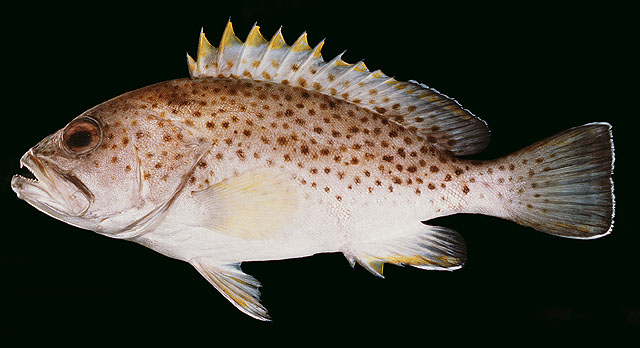| Epinephelidae (Groupers) |
| 100 cm TL (male/unsexed); max.weight: 13 kg |
|
reef-associated; marine; depth range 10 - 100 m, non-migratory |
| Western Indian Ocean: Quissico, Mozambique to East London, South Africa. |
|
Dorsal spines (total): 11-11; Dorsal soft rays (total): 14-14; Anal spines: 3-3; Anal soft rays: 8-8. Distinguished by the following characteristics: head, body, dorsal and caudal fins pale brown, with numerous dark brown spots; ventral parts of head and body lacking spots; juveniles, many of the spots merge to form double spots; prominent dark brown streak along the upper edge of maxillary groove; margin of interspinous dorsal fin membranes yellow or gold; soft dorsal and anal fin dusky distally, with prominent white edge; upper and lower edges of posterior part of caudal fin white edged; pectoral fins yellowish or reddish orange; body depth less than head length, 2.6-3.0 times in SL; head length 2.3-2.5 times in SL; angular preopercle, 2-3 enlarged serrae at the angle; upper edge of operculum straight or convex; naked maxilla, without a step on ventral edge; caudal fin truncate, corners rounded in adults, posterior edge convex in juveniles; lateral body scales ctenoid, with few auxiliary scales in adults (Ref. 089707). |
| Found over rocks and corals at depths of at least 100 m. Feeds mainly on benthic invertebrates, also on fishes and squids (Ref. 4787, 5213). |
|
Vulnerable (VU); Date assessed: 20 November 2016 (A4bd) Ref. (130435)
|
| harmless |
Source and more info: www.fishbase.org. For personal, classroom, and other internal use only. Not for publication.
